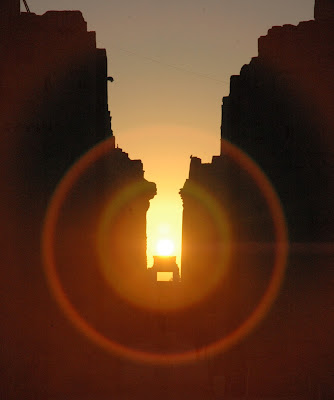Test #5 North South East and West
Fact #1. In temperate and tropical latitudes (south of the Arctic Circle, north of the Antarctic Circle), the sun rises in the east and sets in the west. On a flat horizon, sunrise will be due east and sunset due west twice a year, on the vernal equinox (near March 21) and the autumnal equinox (near September 21). The site of Dzibilchaltun in Yucatan is justifiably famous with tourists partly because of spectacular site alignments on equinox sunrise.
 |
| Equinox sunrise, Dzibilchaltun |
 |
| Equinox sunrise + 30, Dzibilchaltun near Merida |
 |
| Serpent image created by the equinoctial afternoon sun |
Fact #2. The earth's spin axis is tilted 23.5 degrees from the plane of the ecliptic, the hypothetical plane that intersects both the earth and the sun. This tilt causes the seasons as days in the northern hemisphere lengthen toward summer solstice (near June 21) and shorten toward winter solstice (near December 21).
 |
| Visual representation of earth's tilted axis |
 |
| Entryway, Temple of Karnak, Winter Solstice |
Moonrise and moonset points follow a more complex but ultimately similar pattern. The new moon rises due east and sets due west on the spring and fall equinoxes, just as the sun does. The full moon does the same. The waxing moon rises due east and sets due west on the summer and winter solstices, which is opposite the sun's behavior. The waning moon does the same. As the moon goes through its phases, it will rise and set at points on the horizon that vary (at the equator) by the 23.5 degrees of the earth's tilt + the 5 degrees of the moon's own tilt. Like sunrise and sunset points, the amount of moonrise/set variation north and south of due east/west increases as one moves from the equator to higher latitudes. This graph from Paul Middents of the Battle Point Astronomical Association shows lunar rise/set point variation on the horizon relative to solar rise/set point variation across the 18.6 years of a Draconic Cycle.
As the graph shows, some years the variation in moonrise points will be up to 5 degrees smaller than the variation in corresponding sunrise points. Some years the variation in moonrise points will be up to 5 degrees greater. Like the sun, the apparent movement of the moon will always center on due east and due west.
Venus, the evening and morning star, exhibits similar predictable behavior in the sky rising and setting on the horizon at points in between the solar and lunar maximums. The apparent motion of Venus is affected by its sidereal period (225 days), its synodic period (583.9 days), the tilt of its axis (2.7 degrees away from the plane of the ecliptic) and its interaction with earth's sidereal period (365.256 solar days). The ancient Assyrians were careful observers of the planet's movements as shown in the Venus Tablet of Ammisaduqa on display in the British Museum. This 7th century B.C. copy of a 17th century B.C. text was in the library at Nineveh.
Venus, the evening and morning star, exhibits similar predictable behavior in the sky rising and setting on the horizon at points in between the solar and lunar maximums. The apparent motion of Venus is affected by its sidereal period (225 days), its synodic period (583.9 days), the tilt of its axis (2.7 degrees away from the plane of the ecliptic) and its interaction with earth's sidereal period (365.256 solar days). The ancient Assyrians were careful observers of the planet's movements as shown in the Venus Tablet of Ammisaduqa on display in the British Museum. This 7th century B.C. copy of a 17th century B.C. text was in the library at Nineveh.

